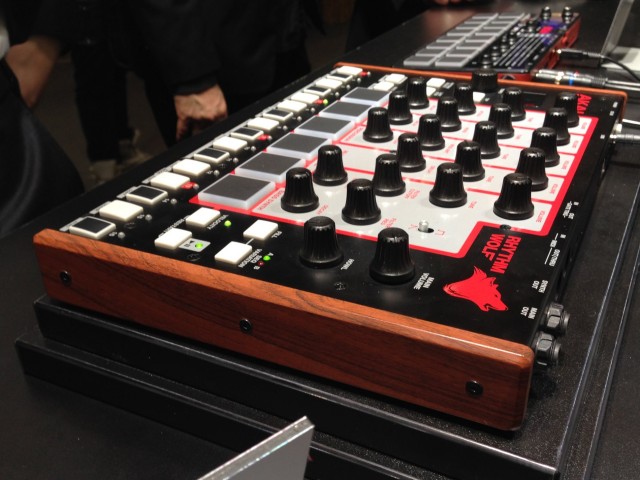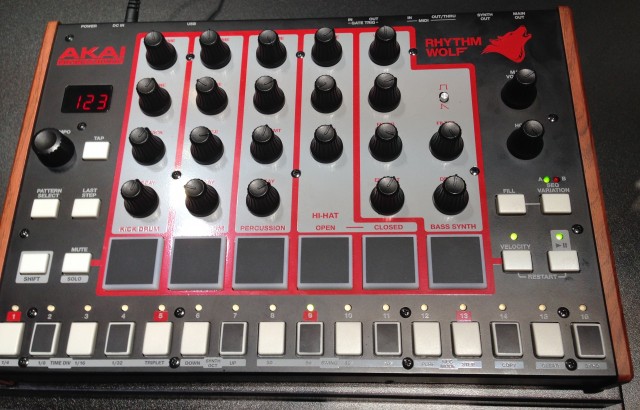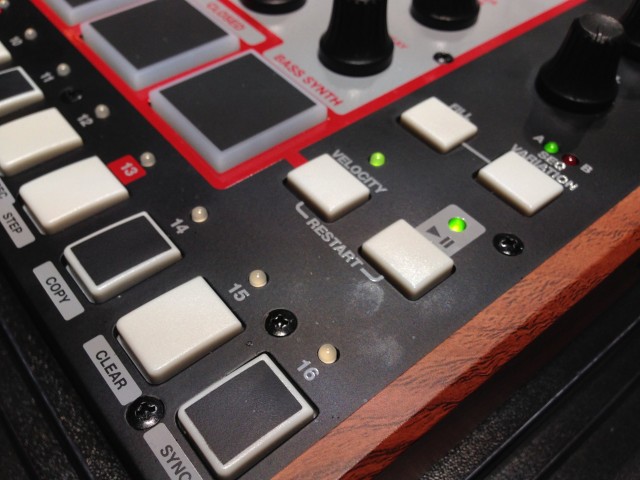As I suspected, Akai did not have a working, sounding model of the upcoming Rhythm Wolf drum machine. But I did get my hands on a prototype with sequencing firmware, got a sense of what the build will be like, and got to talk with Akai more about the design ideas behind this groove machine.
Here’s what it feels like to pick it up:
This thing feels great – not toy-like. This was the big (and pleasant) surprise for me. Whatever the Rhythm Wolf may sound like, at least it feels serious. In fact, it’s:
Real metal. Fake wood. The chassis is all metal, which gives it a more rugged feel, keeps the panel from flexing, and by making the unit a little weightier, keeps it firmly in place as you bang on those pads. The only plastic in the enclosure, ironically, is those faux-wood end panels. (That’s right – they’re plastic, not wood.) The prototype knob caps felt nice enough, too, and Akai says they’re continuing to improve the pots.
What will it sound like? Both the drum set and sounds are said to be something new. The drum engine – with kick, snare, hats, and “percussion” – is a new analog engine that draws inspiration from the 808 and CR-78, we hear from the engineers. The bass synth is a single-oscillator synth that’s “something new,” not just a 303 knock-off (though still probably somehow related to a 303, if distantly). Of course, right now, the Messe Rhythm Wolf isn’t analog but acoustic, making the pristine sound of silence. (John Cage rave!) But these seem like no-brainers to me as far as direction; we’ll see how good Akai’s engineers are at analog synth circuitry shortly.
I’m less optimistic about the bass synth – a single-oscillator synth with no LFO is a bit limiting – but even if you mostly use the drums, this could be a winner.
Oh, and I can confirm, the percussion is some kind of “metallic,” pitch-able percussion – and Akai is promising wide tuning ranges for all the parts with those tuning knobs. (A lack of tuning range was for me a disappointment on the Roland AIRA hats.)
Those are truly velocity-sensitive pads. You get a full 0-127 range on the pads. You just can’t record the full range into the sequencer; it uses instead quantizes to three velocity levels. The pads aren’t huge, and without sound or a velocity read-out it was impossible to tell how well they were working, but it’s still nice to have them rather than just triggers.
There is a real sequencer there. Okay, it was the only part that was working, but it’s still good news. There’s storage for 16 patterns, each with 32 steps. There’s a fill button. There’s a full range of time divisions. There are copy, clear, and last step functions. It’s not a complex sequencer, but the bases are covered.
There’s a “tune” knob for the synth. It’s only a single oscillator, so this really is tune, not detune (shame). But there’s a center detent, and some range for pitching up and down. One of the Akai gentlemen pointed out that this is useful if you’re sequencing directly on the unit, since there’s no pitch bend unless you connect a keyboard, etc.
There’s room on the back panel for extra audio outs – hello, hackers. Without being able to open up the Rhythm Wolf, I have no idea how practical this hack would be. But is there room on the back panel to add jacks for separate outputs from the drum synth? Yes. There is.
Thank KORG. Or EDM. Or both. Off the record, I’m hearing that Akai has been pitching this kind of drum machine for half a decade – this wasn’t an idea that just came to them after seeing the KORG volca beats. But it seems the upswing in interest in drum machines, and KORG’s effective demonstration that the entry level price is a good place to be, finally got them to pull the trigger. Whatever the reason, I think we’re glad it’s happening.
Roland AIRA comparisons don’t make much sense. The reality of the marketplace is that consumers will choose between a $200 drum machine and a $500 one. And why not? Keeping $300 in your pocket is a good thing.
But I don’t think AIRA TR-8 comparisons make so much sense. We’ve heard the TR-8, and it sounds really good. (I know quite a few long-time 808 and 909 owners who were impressed, certainly at the price.) Now, the TR-8 may not be a perfect 808 emulation, but the Rhythm Wolf isn’t even attempting an 808 emulation. The AIRA has a range of 808/909 sounds, whereas the Rhythm Wolf looks very limited. (Clap your hands, say – oh, there’s no clap.) I think the Rhythm Wolf will be a lot of fun, but it’s not broad enough to be your go-to drum machine on every track or performance. And the TR-8 has far more extensive hands-on controls. If anything, a long look at the Rhythm Wolf might make you opt for the TR-8 (or, if you want to spend more money, a boutique drum machine like the brilliant MFB Tänzbar).
Anyway, no matter. Whatever people say in comments, I think the TR-8 and Rhythm Wolf and volca beats will all be hot sellers – and this category can probably support still more affordable machines of this type.
That’s enough to say about a synth that makes no sound. Stay tuned; I’ll make sure Akai gets us one of these when it does start producing noises.


